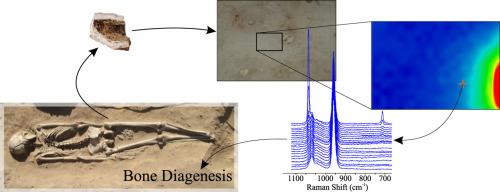Talanta ( IF 5.6 ) Pub Date : 2017-10-31 , DOI: 10.1016/j.talanta.2017.10.059 Gregorio Dal Sasso , Ivana Angelini , Lara Maritan , Gilberto Artioli

|
Retrieving the pristine chemical or isotopic composition of archaeological bones is of great interest for many studies aiming to reconstruct the past life of ancient populations (i.e. diet, mobility, palaeoenvironment, age). However, from the death of the individual onwards, bones undergo several taphonomic and diagenetic processes that cause the alteration of their microstructure and composition. A detailed study on bone diagenesis has the double purpose to assess the preservation state of archaeological bones and to understand the alteration pathways, thus providing evidence that may contribute to evaluate the reliability of the retrieved information. On these bases, this research aims to explore the effectiveness of Raman hyperspectral imaging to detect types, extent and spatial distribution of diagenetic alteration at the micro-scale level. An early-Holocene bone sample from the Al Khiday cemetery (Khartoum, Sudan) was here analysed. Parameters related to the collagen content, bioapatite crystallinity and structural carbonate content, and to the occurrence of secondary mineral phases were calculated from Raman spectra. The acquired data provided spatially-resolved information on both the preservation state of bone constituents and the diagenetic processes occurring during burial. Given the minimal sample preparation, the easy and fast data acquisition and the improvement of system configurations, micro-Raman spectroscopy can be extensively applied as a screening method on a large set of samples in order to characterise the preservation state of archaeological bones. This technique can be effectively applied to identify suitable and well preserved portions of the analysed sample on which perform further analyses.
中文翻译:

拉曼高光谱成像是研究化石骨骼成岩作用的有效且高度有用的工具
对于许多旨在重建古代人口过去生活(即饮食,流动性,古环境,年龄)的研究,检索考古骨骼的原始化学或同位素组成非常重要。但是,从个体死亡开始,骨头经历了几次透液和成岩过程,从而导致它们的微观结构和组成发生了变化。对骨骼成岩作用的详细研究具有双重目的,即评估考古骨骼的保存状态并了解其变化途径,从而提供可能有助于评估所检索信息的可靠性的证据。在这些基础上,本研究旨在探索拉曼高光谱成像在微观尺度上检测成岩作用类型,程度和空间分布的有效性。这里分析了Al Khiday公墓(苏丹喀土穆)的全新世早期骨骼样品。由拉曼光谱计算出与胶原含量,生物磷灰石结晶度和结构碳酸盐含量以及次生矿物相的发生有关的参数。采集的数据提供了关于骨骼成分的保存状态和埋葬期间发生的成岩过程的空间分辨信息。由于只需最少的样品准备,简单而快速的数据采集以及系统配置的改进,微拉曼光谱法可以广泛地用作对大量样品的筛选方法,以表征考古骨骼的保存状态。











































 京公网安备 11010802027423号
京公网安备 11010802027423号